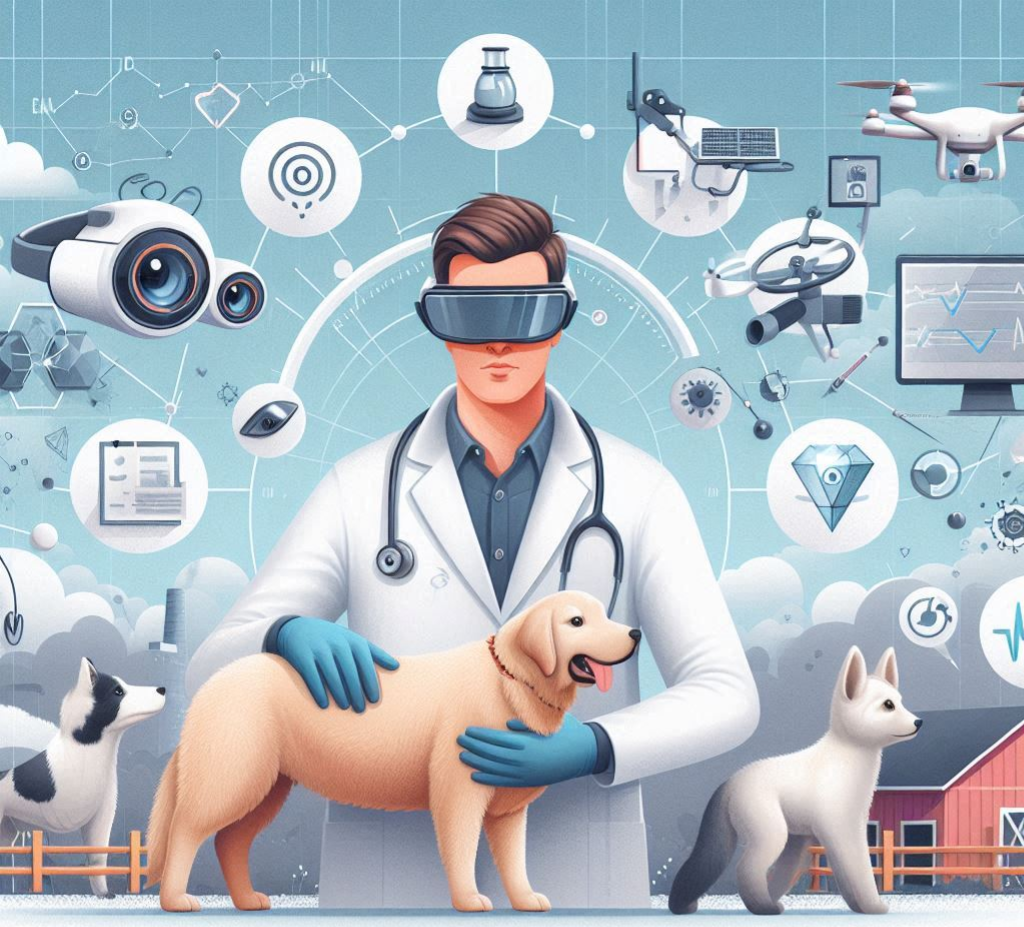Introduction
Our furry (or feathery or scaly) friends deserve the best lives possible. That means keeping them healthy and happy, which goes hand-in-hand with good animal welfare. But how do we know when Fido’s feeling stressed or Buttercup the cow isn’t quite herself? Here’s the thing: traditional methods for checking on animal well-being can be a bit hit-or-miss. Checking in on every moo or meow gets tough, especially with larger groups. And sometimes, it’s hard to tell exactly how they’re feeling.
From the power of artificial intelligence (AI) to the magic of wearable sensors, a new wave of tech is transforming veterinary medicine. This isn’t just about the latest gadgets for your pampered pooch (although those can be pretty cool too). It is about harnessing technology to create a future where every animal, from our beloved pets to the farm animals that provide us with food, receives the care they deserve.
We’re not talking about robot vets (yet!) but rather cutting-edge tools like computer vision, artificial intelligence, and even virtual reality. These technologies offer the potential for continuous, objective monitoring, allowing us to pick up on subtle signs of discomfort or illness before they escalate.
The Role of Technology in Veterinary Medicine and Animal Welfare
The future of animal wellness is all about super-smart tech that helps us understand our furry and feathered friends better. This means happier, healthier animals, which we can all get behind!
Interestingly, the global artificial intelligence (AI) in animal health market size was estimated at USD 997.33 million in 2022 and is expected to grow at a compound annual growth rate (CAGR) of 17.6% from 2020 to 2030 (Grand View Research, 2023).
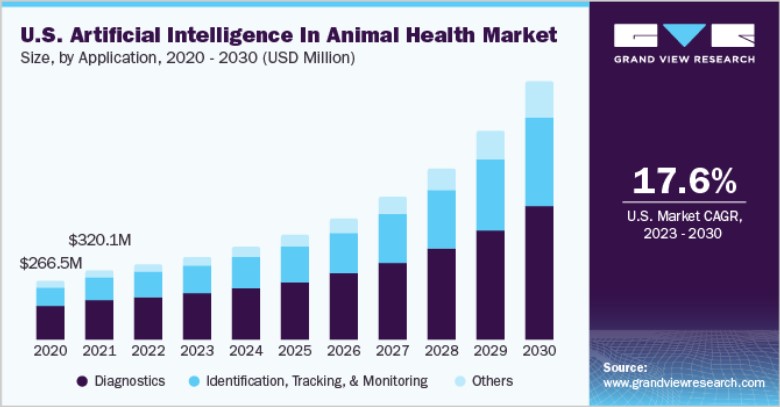
Here’s how some awesome tech tools are changing the game for vets and their patients:
See What They See with The Superpower of Computer Vision
This might sound like magic, but computer vision in veterinary medicine is real! Analysing video footage of animals can pick up on subtle signs of stress, pain, or even illness based on their body language, posture, and how they move around.
This goes far beyond human observation. Unlike us, computer vision can monitor animals continuously, 24/7, without needing breaks. This allows for much earlier detection of health issues in animals.
Use Case
Lameness is a major concern in the industry, causing cows significant pain and impacting milk production.
Studies say that lameness in cows ignites a negative chain with many impacts on both the farmer and the cow, including reduced milk yield (approximately 20% reduction), loss of reproduction, lack of weight gain, and, often, animal culling (Garvey, 2022).
The beauty of computer vision is that it can identify even subtle changes in a cow’s gait, allowing for early intervention and treatment.
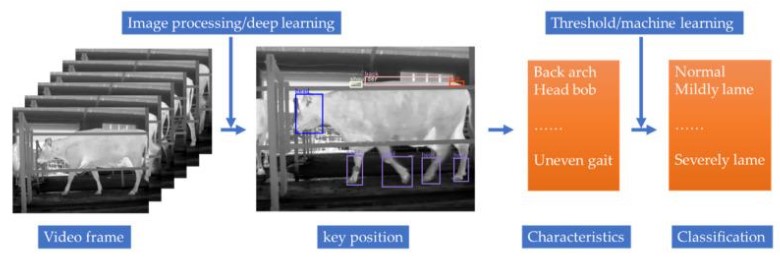
This translates to happier, healthier cows, reduced economic losses for farmers, and, ultimately, a more sustainable dairy industry.
Generative AI to the Rescue for Pet Pain
Ever wonder if your furry friend feels the same pain as you do, but way worse because they can’t meow or bark it out? Traditionally, vets rely on physical examinations and observations, which can be subjective. That’s where some Generative AI comes in. Advancements in Gen AI are revolutionising pain management for animals.
Gen AI acts like the Vet’s assistant, learning from all the animal patients who’ve come through the door.
It analyses mountains of historical veterinary data, including past cases, successful treatment plans, and even animal behaviour patterns. By studying how different species and breeds react to pain, this AI can predict the level of discomfort your pet might be experiencing.
Here’s where it gets truly pawsome: based on this analysis, the AI generates personalised pain management protocols.
The AI considers your pet’s species (a cat needs a different medication than a horse!), breed (a Great Dane requires a different dosage than a Chihuahua!), and even their individual responses to past pain medication. This personalised approach ensures your furry friend receives the most effective and comfortable relief possible.
The benefits are twofold. First, targeted pain management reduces the risk of over-medicating, which can have unpleasant side effects. Second, it ensures your pet receives the appropriate amount of medication to feel better faster. No more mystery ouchies or guessing games! Generative AI empowers vets to provide personalised pain relief for each animal, leading to happier and healthier pets.
The Need for Speed with GPU Acceleration
GPU Acceleration supercharges your computer’s computation power. This extra power is crucial for running the intricate algorithms behind computer vision and generative AI in veterinary applications.
With GPU acceleration, data analysis and model training become significantly faster. This allows vets to leverage these technologies more effectively, leading to quicker diagnoses and improved animal well-being. It’s like having a high-performance race car under the hood, speeding up the process of unhiding valuable insights from animal data.
Keeping an Eye on Every Feather and Fur with IoT Edge Computing
Having a tiny guardian angel constantly monitoring your pet’s well-being, even when you’re not around, is becoming a reality thanks to IoT Edge Computing!
It uses small, wearable sensors attached to animals that collect vital data such as heart rate, temperature, and respiration.
But it doesn’t stop there! These sensors can also track environmental factors, like ammonia levels in poultry houses, which can be harmful to birds.
The key here is edge computing. This means the data is processed and analysed directly on the device or a nearby hub rather than needing a constant connection to the cloud. This allows for real-time monitoring, giving vets a continuous stream of information about their animal patients’ health.
The benefit - early detection of health issues becomes a breeze, allowing for timely intervention and improved treatment outcomes.
Additionally, continuous monitoring of environmental factors helps maintain optimal conditions and prevent the spread of illness, leading to better biosecurity across farms and animal facilities.
IoT Edge Computing is like having a tiny health watch for your pet, keeping them healthy and happy!
Text Becomes a Voice for Animal Welfare with Natural Language Processing
NLP acts like a super translator, deciphering the unstructured text data in mountains of reports. It can analyse vast amounts of information, identifying trends and patterns related to animal welfare concerns. Think of it like a detective combing through case files, uncovering hidden clues!
For example, NLP software can scan vet reports from a specific region and identify a spike in cases of a particular illness. This early detection allows for quicker intervention and the development of targeted solutions. By analysing research data, NLP can also inform best practices and policy development, ultimately leading to improved animal welfare standards across the industry. In essence, NLP unlocks the hidden language within veterinary data, allowing us to make informed decisions for a healthier future for all animals.
Level Up Vets and Animal Care with AR/VR Technology
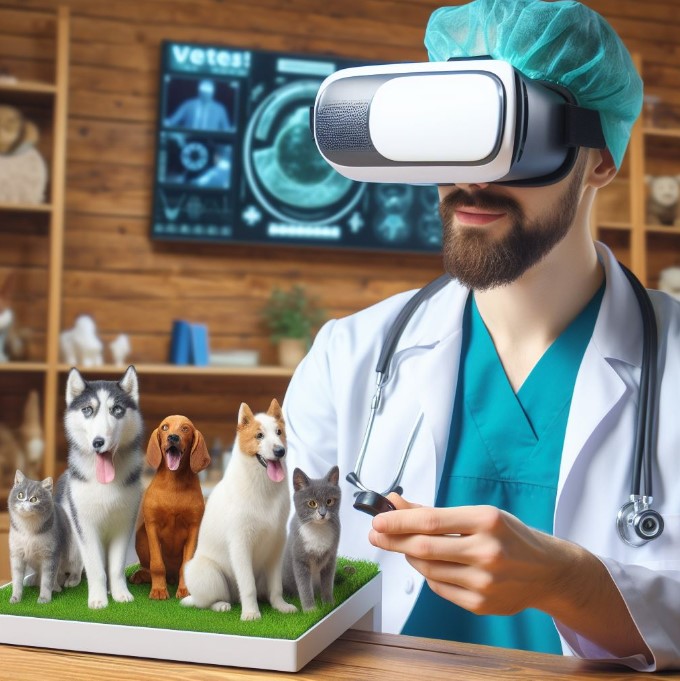
Vet students and professionals can hone their skills in a way that’s both futuristic and fantastic – with Augmented Reality (AR) and Virtual Reality (VR). It can enable practising complex surgeries on virtual animals or having an anatomically correct 3D model appear on a real animal during surgery.
This AR/VR tech creates immersive training experiences that are not only safe for animals but also incredibly cost-effective. It lets vets practise difficult procedures in a risk-free environment before treating real patients.
With AR overlays during surgery, vets can gain a deeper understanding of an animal’s anatomy, leading to improved surgical precision and, ultimately, better care for our animal friends.
So, AR/VR isn’t just for gamers anymore—information’s revolutionising the world of veterinary medicine!
Tech for Tails: A Look at the Road Ahead
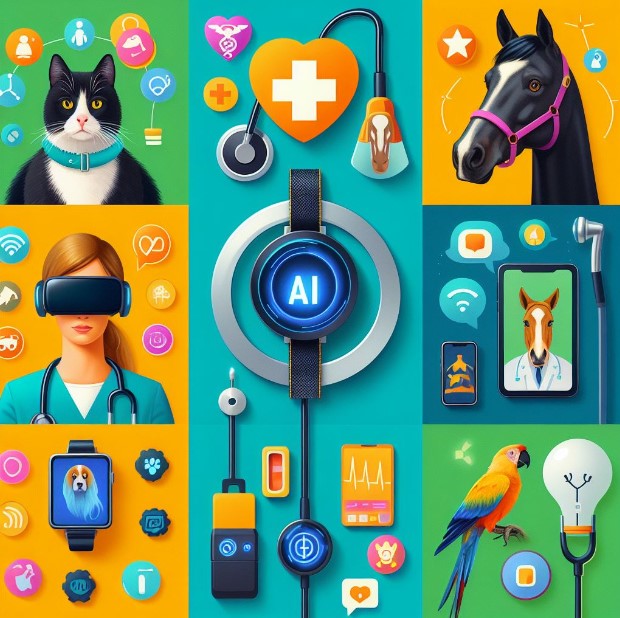
While these advancements in veterinary technology are exciting, it’s important to acknowledge potential challenges and considerations.
First up, privacy. Just like your medical records, your pet’s health data is important. We need to make sure these high-tech tools have top-notch security so no one peeks at their information without permission. Also, when it comes to collecting data from animals, we have to be ethical. While some pets might be happy to sign a consent form (okay, maybe not), it’s important to get the go-ahead from their humans whenever possible.
Another thing to think about is making sure everyone gets to play with these cool toys. Fancy tech can be expensive, and we don’t want smaller clinics or vets in areas with less money to miss out. Maybe some grants, discounts, or even free open-source software can help level the playing field.
Lastly, remember, these gadgets are there to help vets, not replace them. A vet’s experience and knowledge are irreplaceable! Think of it like this: the tech is a super-powered toolbox for vets, giving them even more ways to keep our furry (or feathery or scaly) friends healthy and happy. So, the future of animal care is looking bright, but let’s make sure it’s a future where tech works alongside vets, not the other way around.
Empowering Vets with Tech: How TechnoLynx Can Help
TechnoLynx is at the forefront of developing and implementing cutting-edge technology solutions across various industries. We can bring that same passion and expertise to the veterinary field. We understand the unique challenges and opportunities vets face, and we’re here to help your animal clinic thrive in this new era of tech-driven care.
TechnoLynx is your one-stop shop for all things veterinary tech. We offer a comprehensive suite of services, including:
Computer Vision:
Let us help you harness the power of AI-powered video analysis to monitor animal behaviour and identify potential health concerns early on.
Generative AI:
Our AI solutions can analyse vast amounts of veterinary data to develop personalised pain management plans and optimise treatment outcomes.
IoT Edge Computing:
We can help you implement wearable sensors and edge computing solutions for real-time monitoring of animal vitals and environmental conditions, allowing for proactive interventions.
Natural Language Processing:
Unleash the power of your veterinary data! NLP can help analyse reports and research to identify trends and inform best practices for improved animal welfare.
AR/VR:
Reinvent veterinary education and training with immersive AR/VR simulations that enhance surgical skills and animal handling techniques.
GPU Acceleration
The computers we use for carrying out all the above processes need to be strong and fast. GPU acceleration boosts the performance of these algorithms by enabling them to run at lightning-fast speeds.
These are just a few examples; we also offer custom software development to create solutions customised to your specific needs. We believe in a human-in-the-loop approach where technology empowers veterinary expertise, not replaces it.
Let TechnoLynx help you achieve the full potential of technology in animal care. Contact us today to explore how we can help your animal clinic provide exceptional care and create happier, healthier pets!
Conclusion
Technology is rapidly transforming animal care. These advancements offer a future where subtle health issues are caught early, personalised treatments become the norm, and animal well-being reaches new heights.
However, for this revolution to be truly successful, collaboration is key. Veterinarians, with their irreplaceable expertise, must work hand-in-hand with tech developers to ensure ethical and effective implementation. As we look ahead, the possibilities are boundless.
Contact TechnoLynx today, and together, let’s try to create a world where all animals, from our beloved pets to creatures in the wild, can thrive.
References
-
Garvey, M. (2022, March 17). Lameness in Dairy Cow Herds: Disease Aetiology, Prevention and Management. MDPI.
-
Kang, X., Zhang, X. D., & Liu, G. (2021, January 22). A Review: Development of Computer Vision-Based Lameness Detection for Dairy Cows and Discussion of the Practical Applications. NCBI. Retrieved March 27, 2024.
-
Research, G. V. (2023, March). Artificial Intelligence (AI) In Animal Health Market Report 2030. Grand View Research. Retrieved March 28, 2024.

